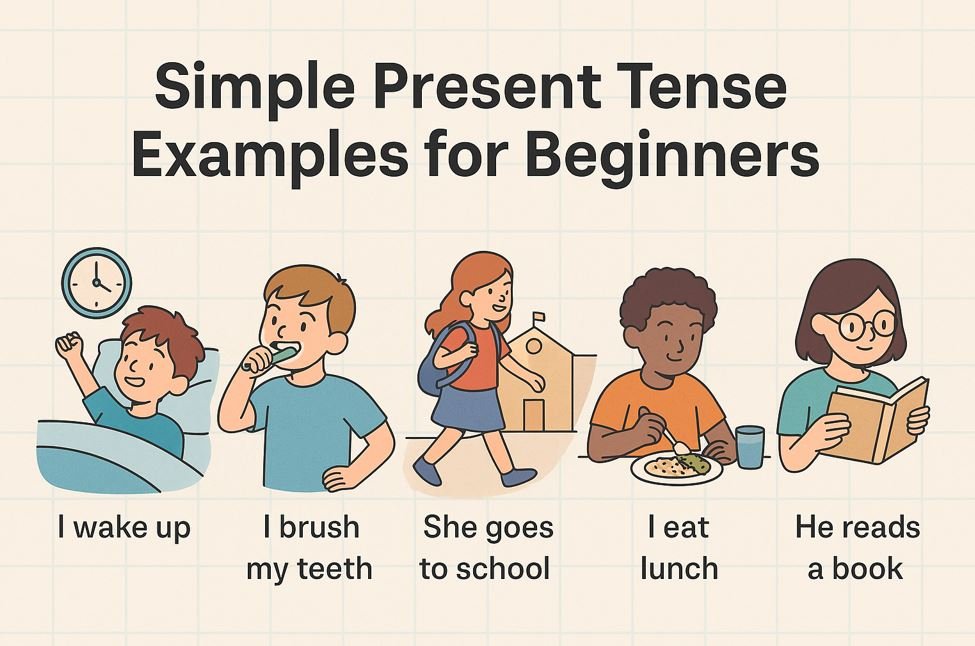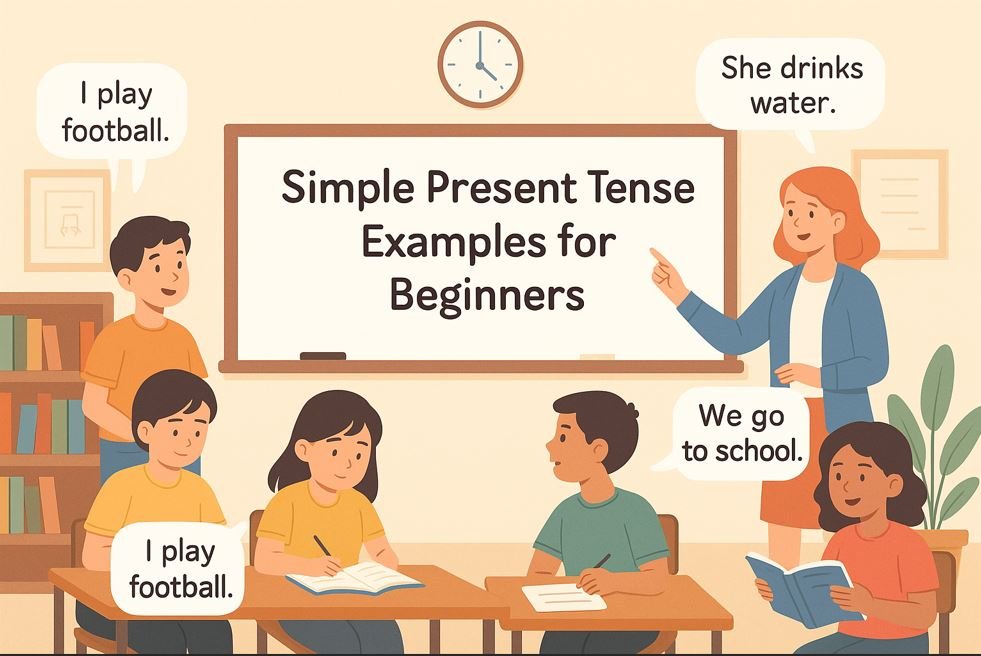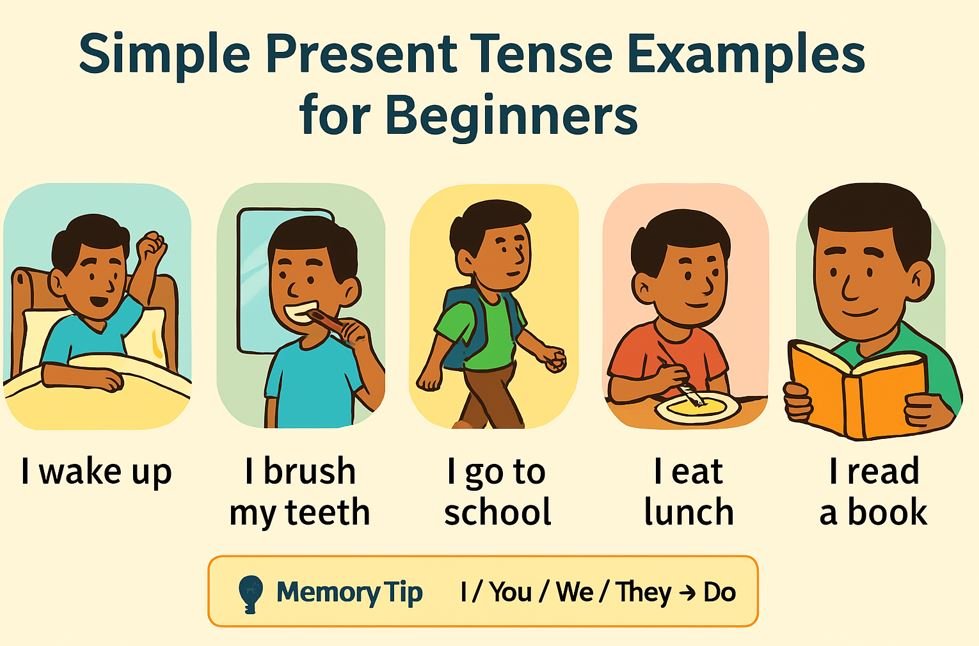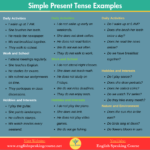Table of Contents
ToggleUnderstanding the Simple Present Tense
When learning English, one of the first and most useful tools you’ll need is the Simple Present Tense. It forms the base of everyday conversation—whether you’re describing your daily routine, stating facts, or sharing general truths. In this guide, we’ll break it down with easy-to-understand Simple Present Tense examples to help you use it with confidence in real life.
In simple words, the Simple Present Tense is used to describe things that happen regularly or are always true. For example:
👉 I wake up at 7 AM.
👉 She loves mangoes.
👉 The sun rises in the east.
Notice how all these sentences talk about regular actions or facts? That’s the power of the simple present.
Many Bengali-speaking learners often ask, “When should I use this tense?” The answer is—whenever you’re talking about daily habits, repeated actions, or facts that don’t change. It’s like capturing the present moment in its simplest form.
In this article, we’ll break down the rules with plenty of Simple Present Tense examples, making it easy for you to not only understand the structure but also use it correctly in real life. Whether you’re a student, job seeker, or someone just starting to learn English, this guide is crafted just for you.
Structure of Simple Present Tense

Now that you understand what the Simple Present Tense is and when to use it, let’s look at how to form sentences using this tense. Don’t worry—once you get the hang of the structure, making your own sentences becomes super easy.
Let’s break it down into three main sentence types: affirmative (positive), negative, and interrogative (question).
✅ Affirmative Sentence Structure (Positive)
This is the most basic and commonly used form. We use it when we want to say something that is true or happens regularly.
🔹Structure:
Subject + Verb (base form) + Object
Here, the verb stays in its base form, but if the subject is he, she, it, or any singular noun, we usually add an “-s” or “-es” to the verb.
🔸Examples:
- I drink coffee every morning.
- She walks to school.
- The baby sleeps at 9 PM.
- They play football on Sundays.
As you can see, these are all Simple Present Tense examples of daily habits and routines.
❌ Negative Sentence Structure
Want to say that something doesn’t happen? Use a negative sentence.
🔹Structure:
Subject + do/does + not + Verb (base form) + Object
We use “do not” (don’t) with I, you, we, they, and “does not” (doesn’t) with he, she, it.
🔸Examples:
- I don’t eat meat.
- He doesn’t like loud music.
- We don’t watch TV at night.
- It doesn’t rain much in summer.
Notice how the main verb stays in its base form even after “does not.”
❓ Interrogative Sentence Structure (Questions)
To ask questions in the simple present, we begin with do or does, followed by the subject and the verb.
🔹Structure:
Do/Does + Subject + Verb (base form) + Object?
🔸Examples:
- Do you play the guitar?
- Does she work here?
- Do they know the answer?
- Does it taste good?
These types of questions are useful in both formal and casual conversations.
🗣️ Quick Tip for Beginners:
Think of it like this:
- Use “s” or “es” with he/she/it in positive sentences.
- Use “doesn’t” instead of “don’t” for he/she/it in negatives.
- Use “does” for he/she/it when asking questions.
Understanding this pattern will make it easier for you to build your own Simple Present Tense examples naturally during conversation or writing.

Helping Verbs: Do vs. Does – Getting It Right
One of the most common areas where beginners get stuck with the Simple Present Tense is understanding the difference between “do” and “does.” If you’ve ever felt unsure about which one to use, don’t worry—you’re not alone!
Let’s make it crystal clear.
🟢 When to Use “Do”
Use “do” with the following subjects:
👉 I, You, We, They
These are either plural subjects or informal references to yourself and others.
🔸Examples:
- I do my homework after dinner.
- You do your job very well.
- We do yoga every morning.
- They do the cleaning on weekends.
In negative and question sentences:
- I don’t like cold drinks.
- Do you speak English?
- We don’t watch that show.
- Do they have a car?
🔵 When to Use “Does”
Use “does” when the subject is:
👉 He, She, It or any singular noun
This is used when referring to one person, animal, or thing.
🔸Examples:
- He does his homework on time.
- She does the shopping every Friday.
- It does not look good.
- Rina does her best in every exam.
In negative and question sentences:
- He doesn’t like spicy food.
- Does she know the answer?
- It doesn’t rain here often.
- Does the teacher explain well?
⚠️ Important Note:
Even when using “does”, the main verb always stays in its base form—no “-s” or “-es” after the verb in negative and question sentences.
✅ Correct: He does not play cricket.
❌ Wrong: He does not plays cricket.
💬 Quick Recap Table:
Subject | Helping Verb | Example |
I / You / We / They | do | Do you like music? / I do my work. |
He / She / It | does | Does he play well? / She does it. |
Mastering do vs. does is a key step in confidently forming your own Simple Present Tense examples, especially when asking questions or forming negatives. Once you get this part right, speaking English becomes a lot smoother!
Examples of Simple Present Tense (Affirmative)
Understanding grammar is important—but nothing beats learning through real-life examples. In this section, we’ll explore how to use affirmative sentences in the Simple Present Tense for three main purposes:
- Talking about daily routines
- Describing habitual actions
- Stating universal truths
These simple uses cover a big part of everyday conversation. So let’s break each one down with clear explanations and useful examples.
⏰ A. Daily Routine Examples
We often use the simple present tense to describe activities that happen every day, like waking up, eating, or going to school.
🔸Examples:
- I wake up at 6 AM.
- She brushes her teeth every morning.
- He takes the bus to work.
- We eat dinner at 8 PM.
- They go to school from Monday to Friday.
👉 These sentences talk about what people regularly do, making them perfect Simple Present Tense examples from daily life.
🔁 B. Habitual Actions
Some actions don’t happen every day, but they are repeated regularly—like visiting a relative every weekend or exercising twice a week. These are also expressed using the simple present.
🔸Examples:
- He visits his grandparents every Sunday.
- I read a book before going to bed.
- She drinks green tea after lunch.
- They play cricket on weekends.
- We watch movies every Friday night.
👉 Whenever you describe a habit—something that happens again and again—you’re using the simple present tense correctly.
🌍 C. Universal Truths
The Simple Present Tense is also used to talk about facts that never change—things that are always true.
🔸Examples:
- The sun rises in the east.
- Water boils at 100°C.
- Birds fly in the sky.
- The Earth revolves around the sun.
- A year has 12 months.
👉 These statements are not about routine or habit—they are permanent facts, and using simple present makes them sound natural and accurate.
🗣️ Speak Like a Native
Try this exercise: Describe your daily life using simple present. Start with:
- I get up at…
- Then I…
- In the evening, I usually…
You’ll quickly notice how often we use the simple present in our day-to-day speech!
So far, you’ve seen how the Simple Present Tense examples can help you express your everyday routine, regular habits, and even scientific truths. Up next, we’ll explore how to form negative sentences with ease.
Examples of Simple Present Tense (Negative)
Once you’re comfortable with affirmative sentences, the next step is learning how to say something doesn’t happen. In English, we do this by using “don’t” (do not) and “doesn’t” (does not)—the key players in negative sentences in the Simple Present Tense.
Let’s explore how to use them correctly.
🔹 When to Use “Don’t”
Use “don’t” with the subjects:
👉 I, You, We, They
🔸Examples:
- I don’t eat meat.
- You don’t play video games at night.
- We don’t live in the city.
- They don’t go to the gym on Sundays.
In each of these examples, “don’t” helps us express what someone does not do regularly.
🔸 When to Use “Doesn’t”
Use “doesn’t” with:
👉 He, She, It or any singular noun
🔸Examples:
- He doesn’t like tea.
- She doesn’t speak French.
- It doesn’t look good.
- The cat doesn’t sleep during the day.
💡 Important Tip:
After “doesn’t”, always use the base form of the verb—no “-s” or “-es” needed!
✅ Correct: She doesn’t cook.
❌ Wrong: She doesn’t cooks.
🧠 Let’s Compare:
Affirmative | Negative |
I play football. | I don’t play football. |
He sings well. | He doesn’t sing well. |
They watch TV. | They don’t watch TV. |
She goes to school by bus. | She doesn’t go to school by bus. |
See how just changing do to don’t or does to doesn’t transforms the meaning?
🗣️ Practice Tip:
Try writing 5 negative sentences about your own routine:
- I don’t…
- He doesn’t…
- They don’t…
You’ll quickly feel more confident using negative forms in conversation.
By understanding how to use don’t and doesn’t, you now have the power to express not only what is happening, but also what isn’t—a big step in mastering English speaking! In the next section, we’ll cover how to ask questions using the Simple Present.
Examples of Simple Present Tense (Questions)
Asking questions is a big part of speaking English confidently. Whether you’re making small talk, asking for directions, or gathering information—the simple present tense is often used.
There are two main types of questions you’ll commonly use:
- WH-questions – to ask for specific information
- Yes/No questions – to confirm something
Let’s look at both with plenty of clear examples.
🔎 A. WH-Questions in Simple Present Tense
WH-questions begin with words like What, Where, When, Why, Who, How, etc. They are used when you want more than just a “yes” or “no” answer.
🔹Structure:
WH-word + do/does + subject + base verb + object?
Use “do” with I/you/we/they
Use “does” with he/she/it
🔸Examples:
- What do you eat for breakfast?
- Where do they live?
- When do you go to bed?
- Why does she cry often?
- Who does he meet on weekends?
- How do you get to school?
Notice how each question is asking for specific details—not just a yes or no.
✅ B. Yes/No Questions in Simple Present Tense
These are short questions that can be answered with “yes” or “no”. They’re super useful in everyday conversations, especially for making polite inquiries or confirming something.
🔹Structure:
Do/Does + subject + base verb + object?
🔸Examples:
- Do you like coffee?
- Does she work here?
- Do they play cricket?
- Does he speak English?
- Do we have class today?
💡 Tip:
Remember, in questions, the helping verb (do/does) always comes before the subject.
🔄 Let’s Compare – Quick Table:
Type | Example Question | Possible Answer |
WH-Question | Where do you live? | I live in Kolkata. |
WH-Question | Why does he study hard? | Because he has exams. |
Yes/No | Do you like music? | Yes, I do. |
Yes/No | Does she cook well? | No, she doesn’t. |
These Simple Present Tense examples show how flexible and practical this tense is when forming questions—helping you stay curious, polite, and clear in conversations.
🗣️ Practice Time:
Try making your own questions:
- What do you do every morning?
- Does your friend like football?
- Do you study at home?
- When do they go to the market?
Ask these to yourself—or even better, practice with a friend. You’ll be amazed at how quickly your fluency improves!
Common Verbs for Practice – Master the Basics
If you want to speak English confidently, you need to get comfortable using everyday verbs. These are the words that describe actions—like eat, go, play, read, and more. And guess what? Most of them are used regularly in the Simple Present Tense.
Practicing with these common verbs will help you build real-life, useful sentences quickly and naturally.
🔤 Most Used Action Verbs in Daily Life:
Here’s a list of beginner-friendly verbs that you should focus on:
- Eat
- Go
- Come
- Play
- Read
- Write
- Watch
- Speak
- Sleep
- Study
- Like
- Work
- Live
- Drink
🧩 Practice Examples in Simple Present Tense
Let’s use some of these common verbs in Simple Present Tense examples so you can see them in action.
🔸Affirmative Sentences:
- I eat rice every day.
- She goes to school.
- They play cricket.
- We read English books.
- He writes in his notebook.
🔸Negative Sentences:
- I don’t drink tea.
- He doesn’t like loud music.
- They don’t come here often.
- She doesn’t read at night.
🔸Questions:
- Do you go to college?
- Does he play the guitar?
- Do they live in this area?
- Does she like ice cream?
Practicing these verbs in all three forms—affirmative, negative, and questions—helps you get a strong grip on sentence formation.
🗣️ Pro Tip:
Choose 5 verbs each day and create your own examples in simple present. Say them out loud or write them in a notebook. This habit will improve your fluency faster than you think!
By now, you’ve seen how essential these everyday action words are for communicating in English. Combine these verbs with the structures you’ve already learned, and you’ll be creating perfect Simple Present Tense examples in no time.
Practice Exercise – Fill in the Blanks
Now that you’ve learned the rules, structures, and common verbs of the Simple Present Tense, it’s time to practice what you’ve learned!
These fill-in-the-blank exercises will help you test your understanding. Don’t worry—everything here is beginner-friendly. Just focus on choosing the correct verb form based on the subject (I, You, He, She, etc.) and the sentence type (affirmative, negative, question).
✍️ A. Affirmative Sentences
Fill in the blanks with the correct form of the verb in brackets.
- I ______ (go) to school every day.
- She ______ (eat) vegetables.
- They ______ (play) football on Sundays.
- He ______ (watch) TV in the evening.
- We ______ (read) English books.
🙅♀️ B. Negative Sentences
Use “don’t” or “doesn’t” as needed.
- I ______ like spicy food.
- He ______ play video games.
- They ______ speak French.
- She ______ drink coffee.
- We ______ go to bed late.
❓ C. Yes/No Questions
Start each sentence with “Do” or “Does”.
- ______ you speak English?
- ______ she live in Delhi?
- ______ they go to the gym?
- ______ he like cricket?
- ______ we have class today?
🔍 D. WH-Questions
Use WH-words (What, Where, When, etc.) + do/does + subject + base verb.
- ______ do you wake up?
- ______ does she go every morning?
- ______ do they eat for lunch?
- ______ does he work?
- ______ do we start the lesson?
✅ Answers Key
- Affirmative:
- go
- eats
- play
- watches
- read
- Negative:
6. don’t
7. doesn’t
8. don’t
9. doesn’t
10. don’t - Yes/No Questions:
11. Do
12. Does
13. Do
14. Does
15. Do - WH-Questions:
16. When
17. Where
18. What
19. Where
20. When
By doing these exercises regularly, you’ll not only understand the rules better but also start using them naturally in conversation. Practice is the secret to fluency!
Answer Key – Practice Exercise
Here are the correct answers to all the questions in the Simple Present Tense practice exercise.
Make sure to check your answers and note any mistakes so you can learn from them!
✍️ A. Affirmative Sentences
Fill in the blanks with the correct form of the verb in brackets.
- I go to school every day.
- She eats vegetables.
- They play football on Sundays.
- He watches TV in the evening.
- We read English books.
🙅♀️ B. Negative Sentences
Use “don’t” or “doesn’t” as needed.
- I don’t like spicy food.
- He doesn’t play video games.
- They don’t speak French.
- She doesn’t drink coffee.
- We don’t go to bed late.
❓ C. Yes/No Questions
Start each sentence with “Do” or “Does”.
- Do you speak English?
- Does she live in Delhi?
- Do they go to the gym?
- Does he like cricket?
- Do we have class today?
🔍 D. WH-Questions
Use WH-words (What, Where, When, etc.) + do/does + subject + base verb.
- When do you wake up?
- Where does she go every morning?
- What do they eat for lunch?
- Where does he work?
- When do we start the lesson?
✅ Tip: If you got any answers wrong, don’t worry! Go back to the relevant section and revise the rules.
With regular practice, you’ll become more confident in using Simple Present Tense examples correctly in everyday conversation.
Tips to Master Simple Present Tense
Learning grammar rules is one thing—but truly mastering the Simple Present Tense requires consistent practice and real-life use. The good news? You can improve your skills right from home—with simple tools and techniques.
Here are some easy daily tips to help you speak and think in English naturally, especially when using Simple Present Tense examples in your everyday life.
🗣️ 1. Speak Daily — Even Just for 5 Minutes
The best way to remember sentence patterns is to use them every day. Pick a time—morning, evening, or before bed—and talk about your daily routine in English.
Example:
- I wake up at 6 am.
- I brush my teeth.
- I drink tea.
- I go to work.
👉 Repeat these daily. You’ll build confidence fast.
🪞 2. Use the Mirror or Recording Method
This is a powerful tip for shy learners. Stand in front of a mirror and talk to yourself in English using simple present sentences. Or, use your phone to record your voice and listen to your pronunciation.
🎤 Say sentences like:
- He doesn’t eat meat.
- Do you like music?
- She reads books every night.
🎯 This helps improve your fluency, confidence, and clarity.
🔁 3. Practice with Daily Routine Examples
Your daily life gives you the best material for practice! Start using Simple Present Tense to describe:
- Morning routines
- What you eat
- Where you go
- What you like/dislike
- Your weekend habits
📝 Keep a small diary and write 3–5 sentences daily:
- I study English in the morning.
- She doesn’t cook on Sundays.
- Do they play in the park?
You’ll naturally memorize sentence structures and verb forms!
🧠 4. Focus on “Do” and “Does”
Since these are often confusing for beginners, try to create 10 examples each with “do” and “does” (affirmative, negative, and questions).
🧩 Example:
- Do you go to school?
- He doesn’t play cricket.
- They do their homework.
The more you see and say it, the faster it sticks.
📌 Final Tip: Consistency Wins
You don’t need to study for hours. Even 15 minutes daily is enough if you focus on speaking, writing, and listening actively. Use Simple Present Tense when messaging friends or even while thinking in your head!
By applying these simple but powerful tips, you’ll soon start using Simple Present Tense examples naturally in conversation—and that’s what fluency is all about!
FAQs – Common Doubts
If you’re still feeling confused, don’t worry—you’re not alone! Many learners ask the same questions when learning the Simple Present Tense. Let’s clear up the most common doubts, once and for all.
📌 Q1: What is the difference between “do” and “does”?
✅ This is one of the most common questions.
Here’s a simple way to remember:
- Use “do” with: I, you, we, they
- Use “does” with: he, she, it or any singular noun
Examples:
- I do my homework.
- He does his homework.
- Do you play cricket?
- Does she like tea?
👉 Bonus Tip: In negative and question forms, the main verb stays in base form (no “s” or “es”).
📌 Q2: Can we use the Simple Present Tense to talk about the future?
Yes! Although it’s called “present” tense, we often use it to talk about scheduled future events—especially those that follow a fixed timetable.
Examples:
- The train leaves at 5 pm.
- My class starts tomorrow.
- The movie begins at 7.
✅ These are future plans with a fixed time or routine—so we use the simple present!
📌 Q3: Is there a difference between spoken and written use?
Great question!
- In spoken English, simple present is used naturally and casually to talk about routines, habits, and general truths.
Example: I go to school. / She doesn’t like coffee. - In written English, it’s also used for the same, but often with a bit more structure or formality.
It’s also commonly used in news headlines, instructions, and literary summaries.
Examples:
- The sun rises in the east.
- Open the book to page 10.
- In the story, the hero fights the villain.
👉 So, the rules are the same, but tone and style may change slightly depending on whether you’re speaking or writing.
Still confused? That’s okay! Keep practicing and revisiting these questions. The more you use the Simple Present Tense examples in daily life, the easier it will become.
Conclusion – Start Using Simple Present Tense Today!
You’ve just taken a big step toward becoming confident in English!
In this guide, you’ve learned:
- What the Simple Present Tense is
- How to use do and does correctly
- The structure of positive, negative, and question sentences
- Plenty of real-life Simple Present Tense examples
- Fun and practical tips to make learning easier
- And answers to the most common doubts Bengali learners face
🌱 Remember, grammar is not just about rules—it’s about real communication. The more you practice with your own daily routine, the more natural English will feel.
🗣️ Final Tip:
Speak a little English every day—even if you make mistakes. That’s how fluency grows. Start small, stay consistent, and don’t give up.
✅ Use the mirror method
✅ Keep a sentence diary
✅ Try speaking with friends or even to yourself in English!




